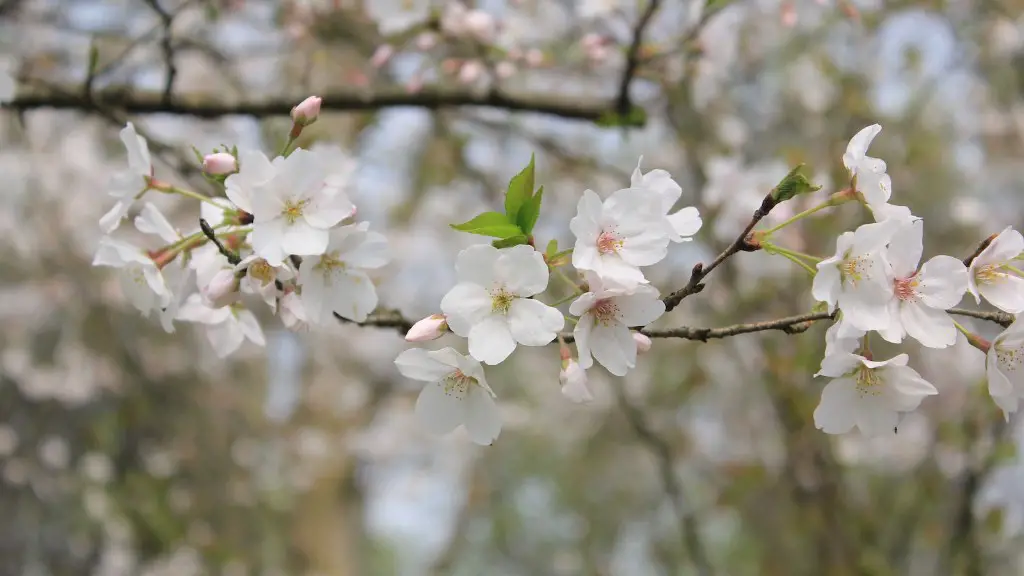The graceful, pink blossoms of the cherry tree regularly reach out to us in early spring, signaling a new season of hope and renewal. But when a cherry tree begins to struggle, it can be a worrying time for tree owners. Going from a beautiful mass of gorgeous flowers to ailing and unproductive is a sad sight. But what can the owner of a struggling cherry tree do to find out if their beloved tree is dying?
First and foremost, it is important to know that many factors can cause a cherry tree to die. Insects, diseases, poor soil, extreme temperatures, and improper care are all possible causes of tree death. Therefore, it is essential to take a step back and look at the whole picture before jumping to conclusions. With that said, these are some of the most common signs of cherry tree death.
The most noticeable telltale sign of a dying cherry tree is branch die-back. This is when the branches at the top of the tree die back and refuse to leaf out. This is usually the result of a deeper-rooted problem such as a fungal infection, water scarcity, or some other issue. If the branch die-back progresses, it could be a sign that the tree is in a terminal state of illness.
Other signs of a dying cherry tree include yellowing or wilting leaves or a drying up of the flower buds. All of these are symptoms of a lack of key nutrients or damaging environmental factors like frost, pests, or machinery. It’s important to take notice if the leaves or buds are changing color compared to what’s normal for the tree. If these issues persist, the tree could be at risk.
Finally, another sign of a dying cherry tree is decreased productivity. If a healthy cherry tree typically produces abundant amounts of fruit, and then suddenly the yield takes a nosedive, it could be a sure sign of a problem. However, a change in production could be caused by a wide range of things, so it should not be taken as an absolute indicator of health.
Healthy Habits
The best way to keep a cherry tree healthy is through regular care and maintenance. Pruning your tree, providing sufficient space around the trunk, and even mulching and adding fertilizer can all contribute to a healthier and longer-lasting tree. It’s also a good idea to keep an eye out for potential pests or diseases that could be damaging your tree, and to take steps to eradicate them if spotted.
It is also important to check your cherry tree for signs of root rot. This occurs when the roots are not receiving enough air or water, and the tree will show signs of wilting or the leaves turning yellow. If a tree is too wet or too dry, it can cause root rot which may eventually lead to the death of the tree. If a cherry tree is suffering from root rot, the best solution is to take steps to improve the drainage around the tree.
Early Detection
It is much easier and less costly to fix these problems when they are identified early on. So, it is important to pay attention to any changes in your cherry tree from year to year. If you have any doubts about the health of your tree, it’s a good idea to consult a tree expert or arborist for a more detailed diagnosis and potential solutions.
It can be hard to watch a beloved cherry tree struggle, but now that you know what signs to look out for, it’s easier than ever to identify a problem early on and take steps to address it. While the decline of a cherry tree can be difficult to watch, it is important to be patient and trust in the experts. With a little knowledge and some careful attention, your cherry tree could live a long and fruitful life.
Fungal Diseases
Healthy cherry trees are not immune to damages by fungal diseases. Mildew, root rot, leaf spots and powdery mildew are some of the more common fungal diseases that can be the death of cherries trees. These fungal diseases progress slowly and it is often too late to save the tree by the time it is visible. Thus, it is important to be vigilant and spot signs of fungal disease when they first appear. A professional arborist can help diagnose a fungal infection and advise on appropriate treatment.
If it is necessary to use chemicals to address a fungal infection, be aware that some may have adverse effects on the environment or local wildlife. For instance, certain fungicides can kill beneficial insects and birds that feed on caterpillars. So, if using any chemicals to treat a fungal disease, it is important to inform yourself and use the safest product available.
Caterpillars
Caterpillars can wreak havoc on a cherry tree and can often be the cause of dying branches and defoliation. If left unchecked, a caterpillar outbreak can be fatal to a cherry tree. As caterpillars enter the tree, they will feed on the leaves and stems, leaving the tree weakened and open to further damage. The caterpillars will then make their way to the bark where their tunneling can lead to infection and death.
The symptoms of caterpillar damage can be hard to spot until significant damage has already been done. Common signs include chewed leaves and twigs, and discolored leaves or branches. Fortunately, there are some ways to get rid of caterpillars before they can cause too much damage. Natural predators that feed on caterpillars are a great way to reduce their populations. Maintaining hygiene and keeping the tree in a healthy state is also a good way to reduce the chance of an infestation.
Environmental Factors
Frost and severe weather can be a major factor in the death of a cherry tree. Cold weather can kill blossoms, drastically reduce the amount of fruit, and weaken the tree’s overall structure. When the ground freezes, it can become difficult for the tree to access the water and nutrients it needs to survive. Severe winters can also invite opportunistic pests and diseases, which can further damage the tree.
It is important to make sure your cherry tree is properly pruned and sheltered during extreme weather. In cold climates, it is also a good idea to make sure your tree is surrounded by plantings that help naturally insulate it from the cold. Installing a protective covering to shield your tree from frost is also an option for cold-climate gardeners.
Conclusion
Cherry tree death is a worry for any tree owner. Knowing the signs of a dying cherry tree and taking steps to address issues, such as root rot and caterpillars, when they first appear is key for ensuring your tree remains healthy. Additionally, keeping the tree sheltered and protected from frost, and understanding the impact of environmental factors, can help contribute to a longer-living tree.



